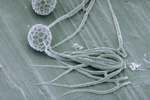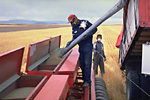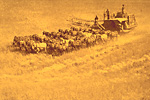Stinking smut (common bunt) of wheat
Tilletia tritici, Tilletia laevis
Wheat, bread and durum
Stinking smut, with its obvious masses of black, smelly teliospores, was noted long before the germ theory of disease was accepted. From the late 1800s until the 1930s, before good seed treatment fungicides became available, stinking smut was a devastating disease of wheat, particularly in winter wheat grown in the Pacific Northwest. It continues to be a problem throughout the world where untreated seed is planted.

Field view of stunted, smut-infected wheat plants.
Symptoms and Signs
Wheat plants
Infected wheat plants often, but not always, tend to be slightly shorter than healthy plants (Figure 1). After heading, the spikelets of infected plants tend to "flare-out" and take on a greasy, off-green color. This "flaring out" of the spikelet is due to the expansion in size of the bunt infected seed that has become filled with teliospores. In cultivars that normally produce long awns (bristle-like structures), infected heads may have shorter awns, or even no awns (Figure 2). In place of normal seeds, infected kernels develop into "bunt balls" (Figure 3). These are the remnants of what would normally be a seed, but in its place, the seed coat remains intact with the inside converted into a black mass of spores (Figure 4). The name "smut," which is derived from the Germanic word for "dirty," comes from this black spore stage. The name "bunt" comes from a dialectic contraction of the term "burnt ears" to "bunt ear" and finally to just "bunt."

Figure 1 |

Figure 2 |

Figure 3 |

Figure 4 |

Figure 5 |
Wheat kernels
The earliest evidence of infection occurs shortly after ovaries would normally be pollinated. Infected ovaries appear greasy with a dark green cast. When squeezed, such ovaries reveal a mass of black spores that smell like rotting fish. This odor is actually that of trimethylamine, which is produced by the smut fungus. As the heads and kernels mature, the bunt balls develop into a hardened mass that looks like miniature footballs. The spores inside the mature bunt balls are released when the heads go through the combine harvester to produce the cloud of dust (Figure 5). This dust also smells of rotting fish. Occasionally, both healthy seeds and bunt balls are found in the same head.
Pathogen Biology
Tilletia tritici, T. laevis
The genus Tilletia was named by the Tulasne brothers in 1847 to honor M. M. Tillet who in 1755 worked with this pathogen in wheat. Since then two species of Tilletia have been shown to be involved in this disease—T. tritici (syn. T. caries) and T. laevis (syn. T. foetida). The two species are distinguished based on the morphology of the bunt spores (Figures 6a and 6b) or by modern molecular techniques, i.e., repetitive sequence based polymerase chain reaction (PCR). Teliospores of T. tritici have ridges on their walls which gives them a “warty” appearance while teliospores of T. laevis have smooth spore walls. Tilletia tritici is found in the drier western areas of the United States whereas T. laevis occurs in the wetter areas of the mid-west and eastern United States.

Figures 6a |

Figures 6b |

Figures 7 |
Reproduction
The two Tilletia species have the same life cycle. Dark-colored teliospores form in bunted kernels and are the overwintering structures. They are released from infected plants (see Disease Cycle and Epidemiology) and land on healthy seeds or on the soil surface. Karyogamy and meiosis occur in the teliospore. When environmental conditions are favorable, each teliospore germinates by producing a short germ tube, technically called a basidium. Shortly after the basidium is formed, long thread-like, light-colored, haploid spores are produced, four or more per basidium (Figure 7). These are called primary sporidia or basidiospores. Genetically compatible sporidia anastomose (fuse) very quickly to form an H-shaped structure (Figure 7), which allows the haploid nuclei in the two sporidia to come together as a dikaryon. The two nuclei do not fuse together, but function as a pair. An infectious hypha develops from the H-structure. This dikaryotic hypha penetrates into the tissue of a germinating seedling and establishes itself just behind the growing point or apical meristem of the wheat plant.
Infection of wheat by the common bunt pathogen represents a race in which the fungus attempts to reach and establish itself in the developing apical meristem of each tiller before internode extension rapidly moves the apex upwards beyond the reach of the fungus. If environmental conditions favor the pathogen, infection and a consequential bunting of the majority of spikes of a susceptible cultivar will occur; conversely, if conditions are not optimal or if plant defense responses impede or stop pathogen ingress, infection will fail resulting in few or no spikes being infected. Just when the wheat head is formed, the hyphae of the smut fungus invade the newly developed seed and begin proliferating rapidly. The hyphae replace the cells of the seed, so that finally only the seed coat remains. Individual cells of the smut fungus then “round up” to form the black, smelly teliospores. The two nuclei eventually fuse to form a diploid nucleus in the teliospore.
Disease Cycle and Epidemiology
Disease Cycle
These two smut fungi survive between growing seasons as teliospores on the surface of healthy seed or in the soil (Figure 4). They can remain viable in either location for a number of years, perhaps ten years or more, particularly if the spores remain dry on the seed surface.
When environmental conditions are favorable, each teliospore germinates, producing sporidia (basidiospores) (Figure 7). After compatible sporidia anastomose (fuse) to form the H-shaped structure, the resulting dikaryotic, infectious hypha penetrates a seedling. As the plant grows, the fungal hyphae also grow, keeping pace with the apical meristerm. Eventually, the hyphae replace the cells of the seed, and the individual cells of the smut fungus become teliospores.
During harvest, the smut spores are released from infected heads as the heads pass through the combine (Figure 5) used to harvest the grain. They contaminate other seed being harvested or are spread by the wind to the soil surface, later to be incorporated into the soil mass during cultivation.

Figure 4 |

Figure 7 |

Figure 5 |
Epidemiology
Cool temperatures (5-15°C/41-59°F) favor the germination of the teliospores. Usually the soil moisture, which favors seed germination, also favors spore germination. Therefore, for winter wheat which is planted in the fall, infection is favored when the seed is planted later when soil temperatures are cooler. Planting winter wheat early late when the soil temperature is above 20°C (68°F) results in very low infection (see Disease Management). In contrast, early seeding of spring wheat when soil temperatures are cool favors infection.
Disease Management
Seed Treatment
Perhaps one of the greatest success stories in plant disease control is found in the use of chemical seed treatments for control of stinking smut. Early in the history of seed treatment, compounds containing copper were used, e.g., copper sulfate. Later, mercury compounds were found to be even more effective, particularly in killing the seedborne teliospores. However, even the mercury compounds on the seed surface were not effective in eliminating infection from soilborne teliospores. The compound hexachlorobenzene (=HCB) was effective, and was widely used in the Pacific Northwest states where soilborne inoculum was prevalent. In recent years, however, even more effective compounds for seed treatment have been developed (Figure 8). Most of these are called "systemic" fungicides because they actually move systemically into and inside of the developing seedling to provide internal protection against the smut fungi. The first such compound was carboxin, which was sold initially in the early 1970s and is still used today. Other systemic fungicides have since been discovered, including difenoconazole and tebuconazole, which are even more effective in small doses than carboxin. To date, no significant problems have occurred with the development of fungicide resistance in the smut fungi. This is probably due to the fact that there is only one cycle of reproduction of the smut fungus each year, rather than multiple cycles as occurs in many of the foliar infecting fungal pathogens where fungicide resistance has been well documented.

Figure 8 |
Seed treatment is relatively inexpensive, very effective, and environmentally safe since very little of the active ingredient is applied per unit of land (Figure 9). For growers who do not want to use chemical seed treatments, the use of organic seed treatment does offer some control, i.e., use of skim milk powder.

Figure 9 |
Resistant Cultivars of Wheat
Stinking smut also can be controlled by the use of disease resistance. In the early part of the 20th Century when highly effective seed treatments were unavailable, a great effort was made by wheat breeders to produce smut-resistant cultivars. Today, that effort is almost nonexistent for two reasons. First, the smut fungus often mutated to form new strains, which could attack the new resistant cultivars. Hence, a cultivar's usefulness in regard to smut resistance was often short lived. Second, the effectiveness of the modern systemic seed treatments has been so great, and the wheat grower's adoption of the practice of treating their seed is so widespread in the "smut prone" areas of the United States, that wheat breeders can spend their efforts on other problems, e.g., yield enhancement, quality enhancement, and resistance to other pests and diseases. While most planted cultivars are susceptible to stinking smut, some are resistant, especially those developed with resistance to dwarf bunt (See Signficance section).
Seeding Date
The severity of stinking smut can also be manipulated to a certain extent by choosing a planting date when the soil temperature is above that for optimal teliospore germination, e.g., above 20°C (68°F). This usually means either early fall seeding for winter wheat, or late spring seeding for spring wheat. While this practice can reduce the incidence of smut, it rarely eliminates the disease altogether. Although this practice can reduce the incidence of smut, it rarely eliminates the disease altogether. Generally, stinking smut is more of a problem in winter wheat than in spring wheat due to the longer period of more favorable temperatures for teliospore germination in the autumn when winter wheat is planted.
Significance
Historical Significance
Stinking smut is a disease that was recognized early in agricultural development because of its prominent symptoms and signs, e.g., black smelly masses of spores in the heads of wheat. As such, it caught the attention of early botanists and agriculturists. M. Tillet, a French biologist became intrigued with the black spore masses in 1755 and actually experimented with them to determine if they could cause the disease. Even though this was prior to the time when the "germ theory of disease" was accepted, he did show that the spores were associated with the disease. However, he believed that it was a "poisonous entity" associated with the black spore masses that actually caused the disease, not the fungus itself. It wasn't until nearly 100 years later that Anton deBary, the Father of Plant Pathology, confirmed the parasitic nature of the smut fungus.
From the late 1800s until the 1930s, stinking smut was a devastating disease of wheat, particularly in winter wheat grown in the Pacific Northwest. Infection levels over 20% were common in Washington in the early 1900s, and between 25-50% of the Kansas wheat crop was lost to stinking smut in 1890. Because of the dusty spore masses released during harvest, many "thresher" explosions occurred. Static electricity that developed around the combine machinery ignited the teliospore dust released by the combine. In 1915, 160 such explosions were reported in Washington. One can visualize the panic that must have developed when a "thresher-combine" pulled by a 20-40 horse team caught fire in the middle of a wheat field from such a smut dust-induced explosion! (Figure 10).

Figure 10 |
Only when the organic mercury and HCB seed treatments became available after 1930 did losses from smut drop to much lower levels. Today, losses from smut rarely occur unless a grower chooses not to plant treated seed.
OTHER BUNTS
Two other bunts of wheat are currently of interest and importance. One is dwarf bunt, also called TCK based on the name of the pathogen and its authority, Tilletia controversa Kühn. This is a disease exclusively of winter wheat since the teliospores only germinate when the soil temperature hovers around freezing for long periods of time, usually 90 days or longer. This condition is usually found under snow cover so dwarf bunt is restricted to areas where winter wheat is grown and that have long periods of snow. Currently, this disease is of economic importance from the standpoint that certain countries have an embargo on the importation of wheat carrying dwarf bunt teliospores. For some time, the United States was not able to sell wheat to China because we could not guarantee to the Chinese that U.S. wheat would carry absolutely no dwarf bunt spores. In 2000, China relaxed its embargo and now accepts wheat shipments with low levels of dwarf bunt teliospores.
Another bunt of economic importance because of its impact on trade is karnal bunt, caused by Tilletia indica. This fungus has a similar biology to that of the other smuts. However its disease cycle is somewhat different in that sporidia are blown up to open flowers, germinate on the stigma, and invade the developing seed. This smut was originally discovered in Karnal, India in the 1930s, but recently was found in Mexico, and now in a few wheat fields in the southwestern portion of the United States, particularly Arizona and neighboring areas of California. Many countries of the world restrict importation of wheat carrying teliospores of karnal bunt. Although the disease causes little yield loss, its greatest impact is because of its effect on wheat trade
Selected References
El-Naimi, M., H. Toubia-Rahme, and O. F. Mamluk. 2000. Organic seed treatment as a substitute for chemical seed treatment to control common bunt of wheat. Eur. J. Pl. Path. 106:433-437.
Hoffmann, J. 1982. Bunt of wheat. Plant Disease 66:979-986.
Hoffmann, J., and J.T. Waldher. 1981. Chemical seed treatments for controlling seedborne and soilborne common bunt of wheat. Plant Disease 65:256-259.
Mathre, D.E. 2000. Bunts and smuts revisited: Has the air been cleared? Plant Health Progress 10.1094/PHP2000-0622-02-RV. http://admin.apsnet.org/edcenter/intropp/lessons/fungi/Basidiomycetes/
Documents/PHP2000_0622_02mathre.pdf
McDonald, J. G. 2000. Differentiation of Tilletia species by rep-PCR genomic fingerprinting. Plant Disease 84:1121-1125.
McNeil, M., A. M. I. Roberts, V. Cockerell, and V. Mulholland. 2004. Real-time PCR assay for quantification of Tilletia caries contamination of UK wheat seed. Plant Pathology 53:741-750.
Wiese, M.V. 1987. Compendium of Wheat Diseases. 2nd Edition. APS Press, St. Paul, MN
